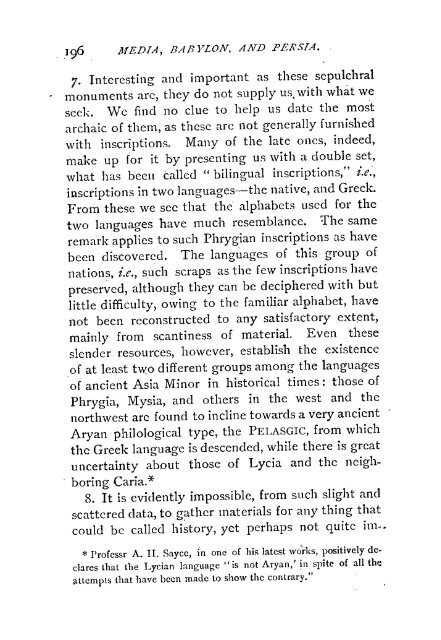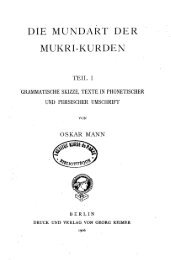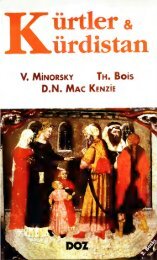- Page 3 and 4:
^ 5t^^' ^ ., " V',! p-ii!^t \ ..Htk
- Page 5 and 6:
Entered at Stationers' HallBy T. Fi
- Page 7 and 8:
IVCLASSIFIED CONTENTS..and follower
- Page 9 and 10:
^'CLASSIFIED CONTENTS.' ' VI.Migrat
- Page 11 and 12:
VI"CLASSIFIED CONTENTS.introducedby
- Page 13 and 14:
CLASSIFIED CONTENTS.yiee. § 4. The
- Page 15 and 16:
XllLIST OF ILLUSTRATIONS.pagbSEPULC
- Page 18 and 19:
PRINCIPAL WORKS READ OR CONSULTED,I
- Page 20 and 21:
PRINCIPAL WORKS CONSULTED.xviiMOlle
- Page 22:
PRINCIPAL DATES GIVEN IN THISVOLUME
- Page 26 and 27:
THE STORY OFMEDIA, BABYLON,AND PERS
- Page 28 and 29:
A NOTABLE RELIGIOUS SURVIVAL. 3popu
- Page 30 and 31:
A NOTABLE RELIGIOUS SURVIVAL.J6. Th
- Page 32 and 33:
ANOTABLE RELIGIOUS SURVIVAL.also kn
- Page 34 and 35:
A NOTABLE RELIGIOUS SURVIVAL. 9and
- Page 36 and 37:
A NOTABLE RELIGIOUS SURVIVAL.IIeven
- Page 38 and 39:
A NOTABLE RELIGIOUS SURVIVAL. 1 3an
- Page 40 and 41:
A NOTABLE RELIGIOUS SURVIVAL. 1 5"
- Page 42 and 43:
II.the PROPHET OF KKAN THE AVESTA.I
- Page 44 and 45:
THE Prophet of eran.i^ing to admit
- Page 46 and 47:
tiie prophet of eran. 21mous propor
- Page 48 and 49:
the PROPHET OF ERAN. 23which of the
- Page 50 and 51:
THE PROPHET OF ERAN. 2$the royal fa
- Page 52 and 53:
THE PROPHET OF ERAN. 27where beyond
- Page 54 and 55:
,,^^wl_y/^/j n^uX^y-fr'iiw jjotj^i
- Page 56 and 57:
THE PROPHET OF ERAN. 3 1Gathas are
- Page 58 and 59:
THE PROPHET OF ERAN.33date It will
- Page 60 and 61:
ARYAN MYTHS. 35cidentally finds som
- Page 62 and 63:
ARYAN' MYTHS. 375. There was a time
- Page 64 and 65:
ARYAN MYTHS. 39 ,for Chaldea, and s
- Page 66 and 67:
ARYAN MYTHS.4IHe is, on the contrar
- Page 68 and 69:
ARYAN MYTHS. 43ber seven. It has al
- Page 70 and 71:
ARYAN MYTHS. 45perficial as our att
- Page 72 and 73:
ARYAN MYTHS. 47ceed in piercing. hi
- Page 74 and 75:
ARYAN MYTHS. 49dwelt in the consecr
- Page 76 and 77:
ARYAN MYTHS. 51the purest and most
- Page 78 and 79:
ARYAN MYTHS. 53setting sun, in the
- Page 80 and 81:
ARYAAr MYTHS. 55who crowd the borde
- Page 82 and 83:
ARYAN MYTHS IN THE AVESTA. '57curti
- Page 84 and 85:
ARYAN MYTHS IN THE AVESTA. 50suppli
- Page 86 and 87:
ARYAN MYTHS IN THE AVESTA. 6lidenti
- Page 88 and 89:
ARYAN MYTHS IN TIIE AVESTA. 63the d
- Page 90 and 91:
Aryan myths in the avesta. 65go up
- Page 92 and 93:
ARYAN myths IN THE AVESTA. 6/and dr
- Page 94 and 95:
ARYAN- MYTHS IN THE AVESTA.6ghorse,
- Page 96 and 97:
ARYAA^ MYTHS IN THE AVESTA.7Ipromis
- Page 98 and 99:
ARYAN MYTHS IN THE AVESTA. 73the me
- Page 100 and 101:
ARYAN MYTHS IN THE AVESTA. 7515. Be
- Page 102 and 103:
ARYAN MYTHS IN THE AVESTA.pof all h
- Page 104 and 105:
ARYAN MYTHS IN THE AVESTA. 79and st
- Page 106 and 107:
ARYAN MYTHS IN THE AVESTA.8lnations
- Page 108 and 109:
ARYAN MYTHS IN TIIE AVESTA. 83diffe
- Page 110 and 111:
Aryan myths in the avesta. 85them u
- Page 112 and 113:
ARYAN MYTHS, IN THE AVESTA. 87four-
- Page 114 and 115:
ARYAN MYTHS IN THE AVES7A. 89spirit
- Page 116 and 117:
ARYAN MYTHS IN THE AVESTA.9Ihis swa
- Page 118 and 119:
ARYAN MYTHS IN THE AVESTA. 93to his
- Page 120 and 121:
V.THE G,A.TT-TAS,THE, Y.\SNA Ol'' S
- Page 122 and 123:
THE GATHAS.gfhad in themselves the
- Page 124 and 125:
THE GATHAS. 99harm on the settlemen
- Page 126 and 127:
THE GATHAS.lOItution of agriculture
- Page 128 and 129:
THE GATHAS. 103"5. Then of these tw
- Page 130 and 131:
* THE GATHAS. 105of Faith known as
- Page 132 and 133:
TIIE GATHAS. 107Most noticeable is
- Page 134 and 135:
THE GATHAS.IO9marks the same schola
- Page 136 and 137:
THE GATHAS.Illnot once mentioned in
- Page 138 and 139:
VI.MIGRATIONS AND FOREIGN INFLUENCE
- Page 140 and 141:
6. " taitidAna" (pen6m)cloth worn b
- Page 142 and 143:
THE VENDIDAD.~THE LESSER AVESTA.11^
- Page 144 and 145:
TONGS TO 'PKIM SACRED FIRE.SAUCERS
- Page 146 and 147:
THE VENDIDAD. THE LESSER AVESTA. 12
- Page 148 and 149:
TIIE VENDIDAD. TIIE LESSER AVESTA.
- Page 150 and 151:
THE VENDIDAD. THE LESSER AVESTA. 12
- Page 152 and 153:
SECTION,TOTAL HEIGHT Ai:OUT l6 FEET
- Page 155 and 156:
130 MEDIA, BABYLON, AND PERSIA.to p
- Page 157 and 158:
132 MEDIA, BABYLON, AND PERSIA." Ur
- Page 159 and 160:
134- MEDIA, BABYLON, AND PERSIA.nat
- Page 161 and 162:
136 MEDIA, BABYLON, AND PERSIA.the
- Page 163 and 164:
138 MEDIA, BABYLON, AND PERSIA.to.A
- Page 165 and 166:
I40MEDLA, BABYLON, AND PERSIA.made
- Page 167 and 168:
142 MEDIA, BABYLON. AND PERSIA.male
- Page 169:
144 MEDIA, BABYLON, AND PERSIA.the
- Page 172 and 173:
THE VENDIDAD. THE LESSER AVESTA. 14
- Page 174 and 175:
THE VENDIDAD. TIIE LESSER AVESTA. I
- Page 176 and 177: 5il6. RUIN OF ATESH-G.^H AT FIR0Z-
- Page 178 and 179: «rf^-!f*> »vft' -1t^^'=?r^>!^»'1
- Page 180 and 181: THE VENDIDAD. TIIE LESSER AVESTA. I
- Page 182 and 183: THE VENDIDAD. THE LESSER AVESTA. 1
- Page 184 and 185: THE VENDIDAD. THE LESSER AVESTA. 1
- Page 186 and 187: THE VENDIDAD. THE LES.^ER AVESTA. l
- Page 188 and 189: THE VENDIDAD. THE LESSER AVESTA. 16
- Page 190 and 191: THE VENDIDAD. THE LESSER AVESTA. 16
- Page 192 and 193: THE VENDIDAD. THE LESSER AVESTA. 16
- Page 194 and 195: VII.THE LAST DAYS OF JUDAH.1. While
- Page 196 and 197: THE LAST DAYS OF fUDAH.17Iat length
- Page 198 and 199: THE LAST DAYS OF fUDAH. 173a short
- Page 200 and 201: THE LAST DAYS OF fUDAH. 1/5warfare,
- Page 202 and 203: THE LAST DAYS OF JUDAH. 1 77tives,
- Page 204 and 205: THE LAST DAYS OF JUDAH. 179soul fil
- Page 206 and 207: THE LAST DAYS OF JUDAH.iSlthe king
- Page 208 and 209: THE LAST DAYS OF JUDAH. ' I S3of th
- Page 210 and 211: THE LAST DAYS OF JUDAH. 185'' There
- Page 212 and 213: LYDIA AND ASIA MINOR * 1 87Halys (t
- Page 214 and 215: LYDIA AND ASIA MINOR. 189into an ac
- Page 217 and 218: 1 8. LYCIAN K0(
- Page 219: 1 8. LYCIAN KOCK-TOMBS AT MYRA,Face
- Page 222 and 223: 192 MEDIA, BABYLON, AND PERSIA.plun
- Page 224 and 225: oH'4uaiu.-MO7-rt^>.ACkO'Ay
- Page 228 and 229: I9§ MEDIA, BABYLON, AND PERSIA.pra
- Page 231 and 232: LYDIA AND ASIA MINOR. 20 1temples,
- Page 233 and 234: »..3-oH»^
- Page 235 and 236: a £z %" a! SO_-1 1< M> u
- Page 237 and 238: LYDIA AND ASIA MINOR. 207and a spar
- Page 239 and 240: LYDIA AND ASIA MINOR.2O9to them so
- Page 241 and 242: 31. RUINS OF THE TEMPLE OF THE UIDY
- Page 243 and 244: o.-IowXazoIti->Z»QZU. HO
- Page 245 and 246: lydia and ASIA MINOR. 21 514. Gold
- Page 247 and 248: LYDIA AND ASIA MINOR. 21?natural, a
- Page 249 and 250: LYDIA AND ASIA MINOR.21Qthat he did
- Page 251 and 252: LYDLA AND ASIA MINOR. 221ter, was t
- Page 253 and 254: IX.BABYLON THE GREATTHE HOUSE EGIBl
- Page 255 and 256: BABYLON THE GREAT. 22$ments, was Ne
- Page 257 and 258: BABYLON THE GREAT. 22/to river, som
- Page 259 and 260: BABYLON THE GREAT. 229TI-Bel, nor c
- Page 261 and 262: BABYLON THE GREAT. 23 1Euphrates, a
- Page 263 and 264: BABYLON THE GREAT. - 233paw, there
- Page 266 and 267: 236 MEDIA, BABYLON, AND PERSIA.10.
- Page 268 and 269: 238 MEDIA, BABYLON, AND PERSLA.type
- Page 270 and 271: 240 MEDIA, BABYLON, AND PERSIA.mona
- Page 272 and 273: 242 media: BABYLON, AND PERSIA.Bala
- Page 274 and 275: 244 MEDIA, BABYLON, AND PERSLA.name
- Page 276 and 277:
246 MEDIA, BABYLON, AND PERSIA.the
- Page 278 and 279:
248 MEDIA, BABYLON, AND PERSIA.a de
- Page 280 and 281:
250 MEDIA. BABYLON. AND PERSIA.long
- Page 282 and 283:
252 ' MEDIA, BABYLON, AND PERSIA.au
- Page 284 and 285:
254 MEDIA, BABYLON, AND PERSIA.cont
- Page 286 and 287:
256 MEDIA, BABYLON, AND PERSLA.vide
- Page 288 and 289:
258 MEDIA, BABYLON, AND PERSIA.caus
- Page 290 and 291:
26oMEDIA, BABYLON, AND PERSIA.in co
- Page 292 and 293:
262 MEDIA, BABYLON, AND PERSIA.Kroi
- Page 294 and 295:
264 MEDIA, BABYLON, AND PERSIA.(mod
- Page 296 and 297:
266 MEDIA, BABYLON, AND PERSIA.conq
- Page 298 and 299:
268 MEDIA, BABYLON, AND PERSIA.high
- Page 300 and 301:
MEDIA, BABYLON, AND PERSLA.^priests
- Page 302 and 303:
^72MEDIA, BABYLON, AND PERSIA.under
- Page 304 and 305:
-274 MEDIA, BABYLON, AND PERSLA.rou
- Page 306 and 307:
276 MEDIA, BABYLON, AND PERSIA.the
- Page 308 and 309:
278 MEDIA, BABYLON, AND PERSIA.how
- Page 310 and 311:
28oMEDIA, BABYLON, AND PERSIA.sacre
- Page 312:
282 MEDIA, BABYLON, AND PERSIA.to t
- Page 315 and 316:
oodWMHZoz;oOSBi-l
- Page 317 and 318:
MEDLA .4ND THE RISE OF PERSIA. 287"
- Page 319 and 320:
XL" KURUSH THE KING, THE AKII/EMENI
- Page 321 and 322:
"KURUSH, THE KING. THE AKH/KMENIAN.
- Page 323 and 324:
"KURUSH, THE KING, THE AKHMMENIAN."
- Page 325 and 326:
"KURUSH, IHE KING, THE' AKHJEMENIAN
- Page 327 and 328:
"KURUSH, THE KING, THE AKHMMENIAN."
- Page 329 and 330:
'Ux"-"'\40, GATE-PILI.AK OL" KYROS
- Page 331 and 332:
41. BAS-RELIEF REPRESENTING KYROS,
- Page 333 and 334:
" KURUSH, THE KING, THE AKHMMENIAN.
- Page 335 and 336:
43- SUPPOSED TOMB OF KAMBYSES I. AT
- Page 337 and 338:
" KURUSH, THE KING, THE AKHMMENIAN.
- Page 339 and 340:
"KURUSH, TIIE KING, THE AKHMMENIAN.
- Page 341 and 342:
"KURUSH, THE KING, THE AKHMMENIAN."
- Page 343 and 344:
"KURUSH, THE KING, THE AKHMMENIAN."
- Page 345 and 346:
"KURUSH, THE KING, THE AKHMMENIAN."
- Page 347 and 348:
"KURUSH, THE KING, THE AKIIJEMENIAN
- Page 349 and 350:
"KURUSH, THE KING, THE AKHMMENIAN."
- Page 351 and 352:
"KURUSH THE KING, THE AKHMMENIAN."
- Page 353 and 354:
"KURUSH, THE KING, THE AKHMMENIAN.
- Page 355 and 356:
"KURUSH, THE KING, THE AKHMMENIAN,"
- Page 357 and 358:
THE KING, THE AKHMMENIAN." 327pleas
- Page 359 and 360:
"KURUSH, THE KING, THE AKHMMENIAN."
- Page 361 and 362:
"KURUSH, TIIE KING, THE AICHMMENIAN
- Page 363 and 364:
APPENDIX TO CHAPTER XLT II E LATE D
- Page 365 and 366:
s^s ^_j .o
- Page 367 and 368:
THE LATE DISCOVERIES AT SUSA. 337un
- Page 369 and 370:
THE LATE DISCOVERIES AT~ SUSA. 339O
- Page 371 and 372:
49. PERSIAN PILLARBASE AND CAPITAL.
- Page 373 and 374:
IPIE LATE DISCOVERIES AT SUSA. 343b
- Page 375 and 376:
KAMBYSES, 529-522 B.C. 34$just the
- Page 377 and 378:
KAMBYSES, i,2(^-i,22 B.C. -347mote
- Page 379 and 380:
KAMBYSES, ^2g-$22 B.C. 349Midianite
- Page 381 and 382:
KAMBYSES, 529-522 .5. C. 351%em mou
- Page 383 and 384:
KAMBYSES, i,2g-e)22 B.C. 353was all
- Page 385 and 386:
^'"'*^'^*Sb^^52 ruined palace at fi
- Page 387 and 388:
KAMBYSES, e,2g-i,22 B.C. 35)^9. Thr
- Page 390 and 391:
360 MEDIA, BABYLON, AND PERSIA.10.
- Page 392 and 393:
362 MEDIA, BABYLON, AND PERSIA.2. A
- Page 394 and 395:
364 MEDIA, BABYLON, AND PERSIA.trib
- Page 396 and 397:
366 MEDIA, BABYLON, AND PERSIA.4. T
- Page 398 and 399:
368 MEDIA. BABYLON, AND PERSIA.The
- Page 400 and 401:
370 MEDIA,, BABYLON, AND PERSIA.the
- Page 402 and 403:
372 MEDLA, BABYLON, AND PERSLA. -wa
- Page 404 and 405:
374 MEDIA, BABYLON, AND PERSIA.pend
- Page 406:
376 MEDIA, BABYLON, AND PERSIA.says
- Page 409 and 410:
DAREIOS L : CIVLL WARS. 37910. Ever
- Page 411 and 412:
DAREIOS I. : CIVIL WARS. 381tians.
- Page 413 and 414:
DAREIOS I. : CIVIL WARS. 383Satraps
- Page 415 and 416:
DAREIOS I.: YEARS OF PEACE. 385die
- Page 417 and 418:
DAREIOS I.: YEARS OF PEACE. 387rich
- Page 419 and 420:
DAREIOS I. : YEARS OF PEACE. 389spr
- Page 421 and 422:
DAREIOS I. : YEARS OF PEACE. 39 1no
- Page 423 and 424:
DAREIOS I. . YEARS OF PEACE.393the
- Page 425 and 426:
DAREIOS I. : YEARS OF PEACE. . 395b
- Page 427 and 428:
PARElds I. : YEARS OF PEACE. 397cov
- Page 430 and 431:
400 MEDIA, BABYLON, AND PERSIA.lie!
- Page 432 and 433:
402 MEDIA, BABYLON, AND PERSIA.whic
- Page 434 and 435:
404 MEDIA, BABYLON, AND PERSIA.has
- Page 436 and 437:
406 MEDIA, BABYLON, AND PERSIA."No-
- Page 438:
408 MEDIA, BABYLON, AND PERSIA.sadl
- Page 441 and 442:
DAREIOS I. : YEARS OF PEACE. 4l'lra
- Page 443 and 444:
DAREIOS I. : FOREIGN WARS. 413He kn
- Page 445 and 446:
DAREIOS I. : FOREIGN WARS. 4I 5(Dni
- Page 447 and 448:
DAREIOS I.; FOREIGN WARS. 417Now th
- Page 449 and 450:
DAREIOS I. : FOREIGN WARS. 4I9(see
- Page 452 and 453:
422 MEDIA, BABYLON, AND PERSLA.arms
- Page 454 and 455:
424 MEDIA, BABYLON, AND PERSrA.He w
- Page 456 and 457:
426 MEDIA, BABYLON, AND PERSIA.lowe
- Page 458 and 459:
MEDIA, BABYLON, AND PERSIA.They had
- Page 460:
430 MEDIA, BABYLON, AND PERSIA.II.
- Page 463:
DAREIOS I. . FOREIGN WARS. 433the n
- Page 466 and 467:
436MEDIA, BABYLON, AND PERSIA.tion
- Page 468 and 469:
438MEDIA, BABYLON, AND PERSIA.Bospo
- Page 470 and 471:
MEDIA, BABYLON AND PERSIA.the Delph
- Page 472 and 473:
442MEDIA, BABYLON, AND PERSIA.Kshat
- Page 474 and 475:
444 MEDIA, BABYLON, AND PERSIA.Neri
- Page 476 and 477:
446 MEDIA, BABYLON, AND PERSIA.-Spe
- Page 478:
ttlfee (3re$l&ai»,Pttg0,I;NWIK, SS
















